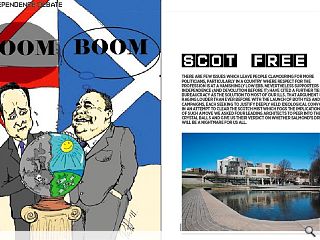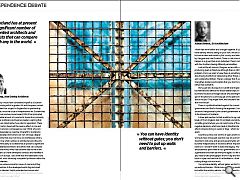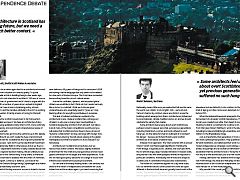Scottish Independence
4 Aug 2012
There are few issues which leave people clamouring for more politicians, particularly in a country where respect for the profession is at a vanishingly low ebb. Nevertheless supporters of independence (and devolution before it) have cited a further tier of bureacracy as the solution to most of our ills. That argument is now raging louder than ever with the launch of both yes and no campaigns, each attempting to justify deeply held ideological convictions. In an attempt to clear the scotch mist which fogs the implications of such a move we asked four leading architects to peer into their crystal ball and give us their verdict on whether Salmond's dream will be a nightmare for us all.
Until recently I would have considered myself as a Scottish architect working within a greater UK and European context. Not dependent nor subject to England but in partnership.
However, since the issue of independence for Scotland has seriously arisen and we move toward 2014 it has prompted an unbelievable amount of scare tactic stories from primarily Westminster politicians and business leaders warning that Scotland faces catastrophe if we vote for separation. These patronising tactics have had the reverse effect on me and I think others and as a consequence, now I think why not.
I consider independence could be of benefit to Scotland in helping us develop and nurture our own stronger, deeper cultural identity that does not focus on shortbread, whisky and tartan. One which centres on architecture and the arts generally. Particularly as Scotland has at present a significant number of talented architects and artists that can compare with any in the world, which has become clear to me in the past few years as I have developed contacts and travelled in the USA and in Europe. I also think that the nationalists have the strongest, most obviously competent politicians within the Scottish Parliament.
There are serious economic issues of course but they affect all countries in the developed world, big and small. Scotland has talented, highly educated and resourceful people which will stand us in good stead, should we choose independence in two years’ time.”
Adrian Stewart, Do Architecture
I think that we’re better and stronger together. It’s possible to have identity without being on your own. We are outsiders but we’ve been welcomed by this country and welcomed by Glasgow and I feel Scottish. There is a lot more that can happen in a group than as an individual. There’s nothing wrong with four brothers having different personalities.
Look at the art scene in Glasgow, we are still a country producing great architecture although there is still the M25 problem. From our point of view there is something great about being Scottish but referencing other things outside, not just Scotland but Britain. There’s a danger that if you start to strengthen borders and isolation that you start to look inwards rather than outwards.
We’ve got lots of projects in Cardiff and England. It would be awkward and difficult for those relationships to change but there would be a thought about why did Brighton Council get on the phone to us and say get on the plane and talk to us about this job? They might think, well shouldn’t we keep this a little more local?
There is a political backlash against the current (UK) government and that’s clouding the argument. Some of the decisions being made by the current government aren’t totally in the interests of Scotland.
A knee jerk reaction to that would be to say, right ok, break off from England. But it’s not black and white. There is a middle ground where you can resist some of the potentially negative decisions which are made in Westminster which can affect someone living on Lewis or Skye - which are worlds apart.
Countries evolve over 1,000’s of years and it would be wrong to have a knee jerk reaction over an economic crisis. Downturns will come and go and governments will change but after independence it would be almost impossible to reverse it. I wouldn’t want to leave that legacy. The decision should almost span three or four governments so it’s crossing a generation and then ask everyone again. It’s like a building, you need to take photographs the first day and then come back in a year and see how it’s all bedded in. I think we’re rushing things a bit too much.
You can have identity without gates; we don’t need to put up walls and barriers. I think more autonomy would be great but within the existing vehicle - there is no need to jump out of the car just yet. It’s a huge burden on our shoulders, we could be burdening 60 generations.
Alistair Scott, Smith Scott Mullan Associates
Will rising to be a nation again lead to an architectural nirvana? Well, the current situation isn’t exactly pretty. To quote from the leader article in Building Design a few weeks ago, “Government is not interested in architects”. BD was of course referring to the UK government and it’s hard to argue with this statement. It’s a number of years since I worked in England but from what I see in terms of planning policy, schools procurement, and the mindless attitude to the VAT on existing buildings question, it hardly smacks of caring for the built environment.
So while the Scottish Government is far from perfect, I am really glad we have it. We have an Architecture Policy (currently being updated) a fairly intact A+DS, more continuity in planning policy and a promised comprehensive review of public procurement.
The economy has got to be the central issue in this debate, because without it we can’t create the type of environment we would all wish for. Scotland has the long term potential for economic success. I just don’t buy the idea that all investment would suddenly take flight to other places and as we live in a global, inter-dependent world this is really a debate about how we carve up regional decision making. We are unlikely to see a total demise of the “British thing” in any event, as there are issues we would need to address with the other UK members, such as transport, currency or defence. Just look at the success of the Oresund Bridge linking Copenhagen and Malmo into one dual nationality economic zone.
At the end of the day economic success is linked to human factors. It is interesting to look at a country like Finland, where a successful economy has developed in spite of half a year of near darkness, fifty years of being next to communist USSR and having a native language that only seems to be related to a few parts of Eastern Europe. The Finns have succeeded because they have the correct cultural values.
Are we the confident, dynamic, well educated global citizens we would like to be? I think not, but I would seriously like us to be. In a nutshell, I think we Scots are great underachievers who essentially need to “grow up”, stop blaming others for everything and believe in ourselves.
This lack of cultural confidence is evident in the architectural scene. I believe Scotland has a strong pool of talent, so why are so many major new buildings in Scotland designed by architects from abroad? Just take a look at many of the major competitions recently and you will realise that Scottish practices have to face a choice of “dynamic collaboration” (or bag carrying) with foreign stars, or not bother entering. We talk about playing in the global marketplace but what we need first is to be valued in our home base.
Architecture in Scotland has a big future, but we need a much better context. We need a slightly sheltered environment for the small and young practices and we need global connection for the larger and more experienced. To do this we need good policy decisions on a range of issues from infrastructure investment to public procurement.
So I am one of the many floating voters. I am certainly not afraid of the notion of independence and believe we could indeed rise and be a nation again. I just need convincing that enough of us possess the right attitudes to be a dynamic and successful one.
Mark Chalmers, Sustrans
Nationality means little once you realise that folk are the same the world over. Welsh, Scots, English, Irish – we’re all Jock Tamson’s bairns. By contrast, places are distinct, as are the buildings which emerge from them. Architecture is influenced by local materials, climate, tradition and so on, and we should celebrate the variety that creates.
Some architects feel uneasy about overt Scottishness, perhaps scared to appear parochial, yet previous generations including Mackintosh, Lorimer and Hurd suffered no such hang-ups. Do the detractors fear an outbreak of crowsteps? No danger – because as Richard Murphy said, Scottish architecture is not about a national style.
Instead, it’s an approach. The “stern exterior with a sensual interior” which Carl MacDougall identified in ‘Painting the Forth Bridge’, is typically Scots. Likewise, the courtyard form, the re-entrant angle, deep-revealed windows in massive walls, and pitched roofs with skew parapets evolved in response to particular conditions. Individually, few of these are unique to Scotland, but in combination they became characteristic.
The notion of Scottishness applies on a city-wide scale, too: our tenement blocks constructed from stone are quite different to the brick-built terraces typically found south of the border. The pattern of riggs and closes in our medieval towns, and the great set-piece of the New Town, aren’t replicated elsewhere, but are distinctly Scots solutions to the universal brief of laying out cities. Some even date back to the days before 1707…
When the National Movement emerged in the 1920s, it formed part of a broader Scottish Renaissance. The Saltire Society was created soon after, then Reiach & Hurd wrote ‘Building Scotland’, a manifesto for a native Scots modernism. From that grew Robert Matthew’s work in the late 1950s, including Dundee and Edinburgh universities, and the hydro stations in the Breadalbane range.
Just as importantly, that generation of Scots architects also took a philosophical position. They published articles, put forward manifestos, and defended their work in public debate. Today’s independence campaign could catalyse something similar, and perhaps find a resonance with Robert Matthew’s declaration that the architect’s task is “to lay the foundations not only of a new architecture, but of a new society”.
Already, devolution has enabled work to begin on the new Forth Bridge, the Alloa and Waverley rail lines, and reconstruction of the A9 and an independent Scotland will need venues for its new institutions.
Why wouldn’t the country which gave birth to the Adam brothers, Mackintosh and Geddes, and has copious natural resources, succeed on its own account?
|
|





